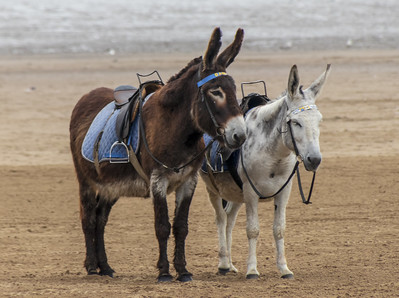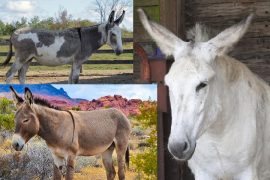Donkeys are popular farm animals, loved by many farm keepers as pets and companions and as help around the farm. Due to their proximity to the horse family, one question always makes its way into any conversation around them. Can you ride donkeys? The short answer is, ‘you can definitely ride donkeys.’ However, there are a few things one needs to consider before they can ride donkeys, such as weight, training, and the donkey’s health. Now let’s dive into the details of riding donkeys.
Can a donkey carry my weight?
When talking about riding donkeys, we first need to look at the weight of the rider to the donkey. We know through extensive research on donkeys in areas such as Ethiopia, India, and Pakistan that donkeys can carry about 20-30% of their weight on their backs, depending on their health. The research also expressed that donkeys carrying more than 50% of their body weight often encounter health issues earlier, such as various types of wounds and parasitic and behavioral problems.
To get into more detail, the weight a donkey can carry is completely dependent on their own body weight; therefore, saying that a donkey can carry x kilograms or pounds might not be true for all. Thus, an exploration into donkey types and how to judge the weight of a donkey is needed.

Types of donkeys and weights they can carry
There are commonly 3 types of donkeys. Namely, miniature, standard, and mammoth, and they range to exactly the same. Miniature donkeys weigh around 200-400 lbs (91-181kg) and 6-9 hh or 25 – 36 inches. Hh being hands-high, which is a common measurement used to measure equine height popularly in America and Britain. The maximum weight a donkey can carry is around 20-30% of their weight, which in this case is 40-8- lbs (18-36 kg)
Standard donkeys weigh around 400-900 lbs (181-408 kg) and 9-14 hh or 36-56 inches. They can carry around 80-180 lbs (36-82 kg).
And lastly, mammoth donkeys weigh around 900-1300 lbs (408-590 kg) and stand tall at 14.4 hh and above or over 58 inches. They can carry the most weight among donkeys, which is 180-260 lbs (82-117 kg).
A common formula used to calculate a donkey’s weight is [(height x girth) x torso length] / 300. And the weight your donkey can carry is around 20-30% of that.
When can a donkey have a rider?
It’s important to note that though a donkey can be trained to carry a rider, they are not born or conditioned to be ridden and, therefore, may not be responsive to training and having a rider. In that case, it’s best to give the donkey space and take baby steps towards the training.
If you’re training a donkey to host a rider, it’s wiser to begin with their training earlier than later but it is recommended that donkeys don’t carry any weight until 5 years of age to decrease the risk of osteoarthritic changes in their bodies due to overworking an underdeveloped body.
Due to their proximity to the horse family, it’s a common misconception that donkeys can be ridden from a young age, which is not true. Therefore, it’s advisable to ride donkeys after they are 5 or 6 years of age but it’s important to start training them earlier, at around 4 years of age.
At this time, you can start to train your donkey with foundation training. This involves ground manners such as wearing a halter, being led around with a rope and verbal commands. These are the foundation blocks to a successful donkey riding training.
How to train a donkey to ride?
The first step to any sort of training or interaction with your donkeys is trust. Building a solid foundation of trust can help you and the donkey be at ease during the training process as well as aid it to go smoother.
This can be achieved by letting your donkey know that you are a safe person to be with by providing them a comfortable environment to live in. You can also cultivate positive feelings by giving them treats when they behave well and such, although, do not make it a habit as it might prove hard to then have them perform tasks without constant reward.
After building trust and teaching them ground manners gently introduce them to riding equipment such as bridles, reins, and saddle pads. Then slowly introduce weights for them to carry and progressively increase them.
A quick tip to help your donkey be comfortable with a saddle is to gradually introduce the weight of the saddle first and then the saddle. This will help them ease into the transition and make it a smooth process.
After introducing the saddle, start training your donkey to carry the saddle for long periods of time and with a lead rope and halter. Once your donkey is comfortable with the full track outfit, you can finally get started with training them for riding. These steps may take time and being patient with them can help build a steady foundation.
Once all the initial requirements are met, start introducing your donkey to human weight. Understand the limits and comfort of the donkey to the weight of the rider and go ahead with the training. Begin by riding them for short distances and gradually increase the distance.
Since donkeys are not openly expressive of their discomfort it’s important to look out for cues that might show discomfort. Common cues include being aloof, not being responsive, constant braying or distress braying, and inert movement or they end up standing still at one place until the stimulant to their distress is removed. At these times, it’s important to take a break and allow your donkey the breathing space to feel comfortable.
Can I ride all kinds of donkeys or is there a specific one?
While all types of donkeys can be trained to have riders, a general understanding is that gelded males are gentler and easier to train, whereas jacks may not be the best option due to their temperament. Jennys can also be suitable for riding, but they can prove slightly unpredictable during heats. Therefore, gelded males are the preferred donkeys for riding.

Is there a difference between riding donkeys and horses?
Most definitely. While horses are faster and often perceived as the more majestic animal, they are also more sensitive to stimuli and can get frightened easily. Horses also give you a more exciting riding experience, but donkeys are more calmer and steady creatures who enjoy slower walks as compared to runs.
Since donkeys are not affected by worldly stimuli like horses are, they are safer to ride as compared to horses. Especially if you’re considering letting children ride animals, a donkey could prove to be the better option given that they are trained for the same.
How to judge if my donkey is healthy enough to ride?
At first glance, a donkey’s health can be judged by its weight. A donkey’s belly when viewed from the back, if it does not protrude beyond their sides and if their ribs are covered lightly by a layer of fat and muscle, then it can be considered a healthy donkey.
Other indications are
- A good muscle development all over the body.
- When you move over the donkey’s spine with slight pressure, if you can feel individual spinous bones, the donkey is considered to be healthy.
- When their hip bones are rounded in appearance, their hindquarters are covered with good muscle, and both these muscles can be felt with light pressure.
These are strong indications of a physically healthy donkey. It’s also important to look into their disposition as well. A well-disposed donkey will have a naturally curious attitude and though slightly hesitant, an open nature to new people and surroundings.
While these are strong indications of a physically healthy donkey, if they show signs of either being underweight or overweight which can be seen by how visible their bones are or how their bellies bulge beyond their sides, it can be detrimental to their health. Maintaining and working towards ideal health helps donkeys keep a happy disposition and be helpful.
Please keep in mind that these judgments are made to judge if a donkey is ready to be ridden and not as a measure of a donkey’s worth in general.
Final considerations
Rounding up the things we spoke about previously:
- It’s perfectly fine to ride a donkey if they are trained to do so and are receptive to the training.
- A donkey can comfortably seat a rider and can be trained to seat a rider at around 5 years of age, when they are adult donkeys. This age requirement is given to preserve a donkey’s health.
- Donkeys can only carry about 20-30% of their body weight safely, without risk to their health. It’s important not to overwork donkeys as it can then develop into health complications.
- A gelded male is the preferred donkey for riding due to their gentler disposition.
- A donkey can be the better choice for riding compared to horses if you’re looking for a slower and more steady riding experience.
- Being patient and gentle with the training can pay off greatly. Donkeys are gentle and loving animals who do not respond well to forceful actions or strong instructions and better respond to positive behavior enforcement. This is the reason why a gentle approach to learning can help them be more responsive and open.
- A physically healthy donkey is judged by how its muscles sit over its body and their body fat. Their mental disposition is judged by their reaction to worldly stimuli and their curiosity.
- During training go slow and steady with introducing weights. You don’t want the donkey to be resistant or hesitant to the training and therefore going at their pace is actually the fastest way for donkeys to be comfortable with being ridden.

![Can You Ride Donkeys? [Don’t Forget These Riding Tips] can-you-ride-donkeys](https://donkeyonfarm.com/wp-content/uploads/2023/03/can-you-ride-donkeys.jpg)

![How Cold is Too Cold for a Donkey? [Plus Tips to Keep Them Warm] How-Cold-is-Too-Cold-for-a-Donkey](https://donkeyonfarm.com/wp-content/uploads/2022/09/How-Cold-is-Too-Cold-for-a-Donkey-270x180.jpg)
![How to Get Rid of Flies on Your Donkey? [Plus Prevention Methods] How to Get Rid of Flies on your Donkey](https://donkeyonfarm.com/wp-content/uploads/2022/05/How-to-Get-Rid-of-Flies-on-your-Donkey-270x180.jpg)

![Should Donkeys Be Stabled at Night? [With Alternatives to a Stable] Should-donkeys-be-stabled-at-night](https://donkeyonfarm.com/wp-content/uploads/2023/04/Should-donkeys-be-stabled-at-night-270x180.jpg)